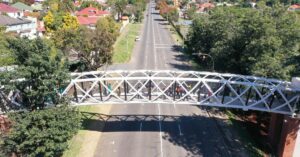Weighing in at 18 tonnes and spanning the length of four lanes of traffic, the pedestrian bridge at Jeppe High School for Girls stands as an enduring testimony to perseverance and courage.
For over 28 years, the students of Jeppe High have had to cross Roberts Avenue in Kensington to get from their classrooms to their sports fields. Roberts Avenue was a dangerous crossing for young learners up until Saturday 11 December 2021, when the pedestrian bridge, made of steel, was hoisted into place. The outcome was a triumph, but the journey there was long and arduous. The bridge arrived after several decades of extensive fundraising, planning and negotiating with the regulatory bodies The late Dina Goncalves, principal at that time, drove the initial planning and fundraising of the project. Kevin Jarvis from Jeppe High School for Boys got involved approximately 5 years ago and he and the team pushed to get final approval for the bridge from all the relevant parties – including the Gauteng Department of Education, the Johannesburg Roads Agency and the municipality. Although it took 28 years to bring the project to fruition, once all requirements were met, the construction was swift. William da Silva and Louis Pretorius of MDS Architects designed the bridge using elegant lines and lighting to create an architectural feature that adds to the aesthetic of the area.Cadcon was the Construction and Engineering company responsible for the construction of the bridge, ensuring that it was completed and erected with as little disruption as possible. The body of the bridge was assembled off-site in Littleton, Centurion.
This was a two-week process that saw the team working 12-hour days, seven days a week. Painting the bridge took another week. The enormous steel structure then had to be transported to its new home, with the help of Redruth Transport, and the sections were assembled on-site by Gauteng Steel Erectors. The use of steel as the medium of construction for this project offered numerous advantages. The ability to fabricate sections off-site and then transport them to their destination ensured quick construction in the field. This was essential to guarantee minimal disruption to traffic. Further, the lower weight of the steel, as compared to concrete, meant erection costs were reduced. The predictable properties of the material also aided design and construction. The final result is now elegant and pleasing. The success of the project was highlighted and recognition was given to CADCON by the South African Institute of Steel Construction at the Inspiring SAISC Steel Awards in 2022, where the bridge got a commendation in the Tubular category. “At Macsteel, we are always proud to be part of projects that not only demonstrate the strength and versatility of our product but change lives while doing so. From start to finish, this project demonstrated the commitment of all involved to do their best for those children and give them a safer environment at school. We recognise and congratulate them all.” said Macsteel CEO, Mike Benfield.







